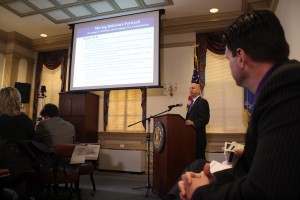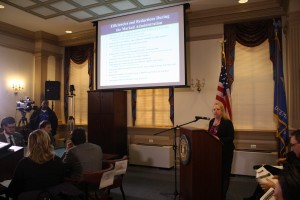Markell FY 2016 Budget Invests in Creating Opportunity for Delawareans; Focuses on Preparing Students for New Economy
Former Governor Jack Markell (2009-2017) | News | Office of the Governor | Date Posted: Thursday, January 29, 2015
Former Governor Jack Markell (2009-2017) | News | Office of the Governor | Date Posted: Thursday, January 29, 2015
Governor highlights efforts to support job growth and strengthen schools as well as make improvements to Substance Use Treatment and Prevention efforts
Budget meets growing demands for services while maintaining fiscal responsibility
Dover, DE – Governor Jack Markell today unveiled a balanced budget proposal that promotes increased educational and job opportunities and strengthens the State’s resources for those battling substance use disorders. The budget maintains the Governor’s commitment to fiscal responsibility by appropriating 98 percent of available revenues and sustaining a fully funded Rainy Day Fund.
“Our budget reflects our values,” said Markell. “We must ensure our children and grandchildren have the same kind of bright future that previous generations left behind for us, and that means concentrating our investments where they can have the most impact in creating economic opportunities for Delawareans.”
At today’s budget release, Markell highlighted the difficult economic times Delaware has faced even as the state has realized significant achievements in creating jobs, strengthening schools, and improving quality of life in the state during difficult budget times. When adjusted for inflation and population growth, the size of government has decreased since 2009.
Supporting Delawareans to Seize Opportunities for a Bright Future
Educating Students for Tomorrow’s Workforce The budget proposes a significant increase in public education funding, including: $15.3 million for 186 new teacher units to meet the demands of increased enrollment in public schools; $9.8 million for salary step increases for school employees; $1.9 million to annualize and continue progress on the pay plan for paraprofessionals.
In addition, Markell outlined $9.5 million in additional state funding based on feedback from teachers, principals, and other school leaders about the initiatives that are having the greatest impact in Delaware classrooms. These resources will support specific requests from the education community and will sustain efforts begun when Delaware won the federal Race to the Top grant at a fraction of the amount provided by the federal government over the last four years. Initiatives include:
“We should be incredibly proud of the progress we’ve made in our schools,” said Markell. “Proficiency is up. More students are reaching their growth goals, and staying on track to graduate high school. The drop-out rate is at a 30-year low. And more students are earning college credit while in high school, and going on to attend and complete college. With the end of the Race to the Top grant, we have an opportunity to evaluate the investments we’ve made and use what we’ve learned about how to best support our students and educators going forward.”
Creating Opportunities for Delawareans with Substance Use Disorders
Like many states across the country, Delaware is facing an addiction epidemic that continues to grow each year.
Last year, 185 Delawareans died from a suspected drug overdose and nearly 10,000 adults sought public treatment for addiction. Governor Markell’s budget makes significant investments in the area of substance use, including $4.5 million for the following improvements:
These efforts are complemented by a focus on education, prevention, and early intervention.
“We will create a more flexible treatment system that meets the needs of individuals challenged by addiction where they are, as opposed to relying on a “one size fits all” model,” said Governor Markell. “At the same time, we will put an increased emphasis on education, prevention, and early intervention.”
Spurring Economic Development and Improving Quality of Life
The Governor’s budget continues efforts to invest in economic development that creates jobs and improves the quality of life in Delaware’s communities. The recommended budget includes:
Ensuring Fiscal Responsibility
As in previous years, the Governor’s budget reflects the challenges of limited revenues despite continued economic growth.
The Governor has proposed a combination of agency and program cuts and reduction to balance the budget while investing in education and economic opportunity in a fiscally responsible way. One of these proposals will reduce the growth of seniors’ property tax subsidy. This subsidy has continued to grow as more Delawareans become eligible for it upon reaching the age of 65. By 2025, the population of Delawareans over the age of 65 is expected to top 21 percent, at a cost to the State of more than $46 million, compared to $8.7 million at the time the program launched in 2001 when seniors accounted for about 13 percent of the state’s population.
The Governor proposes reducing by half the subsidy for those who qualify. Currently, property owners receive a subsidy of $500, or 50 percent of their school taxes if that amount would be less than $500. Under this proposal, property owners would receive a subsidy of $250, or 25 percent of their school taxes if that amount would be less than $250. This will save the State $12.6 million in the Fiscal Year 2016 Recommended Operating Budget.
Final Budget Totals
The Fiscal Year 2016 Recommended Operating Budget totals $3,900.0 million. The proposed Fiscal Year 2016 Recommended Bond and Capital Improvements Act totals $385.8 million and includes $246.8 million in State agency capital projects and $139.0 million in Transportation projects. The Governor also set aside $45.4 million for Grants-in-Aid.
A power point of the proposal is available online: http://governor.delaware.gov/docs/FINAL_FY_2016_budget_presentation.pdf
###
Related Topics: budget, education, jobs, publicsafety, qualityoflife, ResponsibleGovernment
Keep up to date by receiving a daily digest email, around noon, of current news release posts from state agencies on news.delaware.gov.
Here you can subscribe to future news updates.
Former Governor Jack Markell (2009-2017) | News | Office of the Governor | Date Posted: Thursday, January 29, 2015
Governor highlights efforts to support job growth and strengthen schools as well as make improvements to Substance Use Treatment and Prevention efforts
Budget meets growing demands for services while maintaining fiscal responsibility
Dover, DE – Governor Jack Markell today unveiled a balanced budget proposal that promotes increased educational and job opportunities and strengthens the State’s resources for those battling substance use disorders. The budget maintains the Governor’s commitment to fiscal responsibility by appropriating 98 percent of available revenues and sustaining a fully funded Rainy Day Fund.
“Our budget reflects our values,” said Markell. “We must ensure our children and grandchildren have the same kind of bright future that previous generations left behind for us, and that means concentrating our investments where they can have the most impact in creating economic opportunities for Delawareans.”
At today’s budget release, Markell highlighted the difficult economic times Delaware has faced even as the state has realized significant achievements in creating jobs, strengthening schools, and improving quality of life in the state during difficult budget times. When adjusted for inflation and population growth, the size of government has decreased since 2009.
Supporting Delawareans to Seize Opportunities for a Bright Future
Educating Students for Tomorrow’s Workforce The budget proposes a significant increase in public education funding, including: $15.3 million for 186 new teacher units to meet the demands of increased enrollment in public schools; $9.8 million for salary step increases for school employees; $1.9 million to annualize and continue progress on the pay plan for paraprofessionals.
In addition, Markell outlined $9.5 million in additional state funding based on feedback from teachers, principals, and other school leaders about the initiatives that are having the greatest impact in Delaware classrooms. These resources will support specific requests from the education community and will sustain efforts begun when Delaware won the federal Race to the Top grant at a fraction of the amount provided by the federal government over the last four years. Initiatives include:
“We should be incredibly proud of the progress we’ve made in our schools,” said Markell. “Proficiency is up. More students are reaching their growth goals, and staying on track to graduate high school. The drop-out rate is at a 30-year low. And more students are earning college credit while in high school, and going on to attend and complete college. With the end of the Race to the Top grant, we have an opportunity to evaluate the investments we’ve made and use what we’ve learned about how to best support our students and educators going forward.”
Creating Opportunities for Delawareans with Substance Use Disorders
Like many states across the country, Delaware is facing an addiction epidemic that continues to grow each year.
Last year, 185 Delawareans died from a suspected drug overdose and nearly 10,000 adults sought public treatment for addiction. Governor Markell’s budget makes significant investments in the area of substance use, including $4.5 million for the following improvements:
These efforts are complemented by a focus on education, prevention, and early intervention.
“We will create a more flexible treatment system that meets the needs of individuals challenged by addiction where they are, as opposed to relying on a “one size fits all” model,” said Governor Markell. “At the same time, we will put an increased emphasis on education, prevention, and early intervention.”
Spurring Economic Development and Improving Quality of Life
The Governor’s budget continues efforts to invest in economic development that creates jobs and improves the quality of life in Delaware’s communities. The recommended budget includes:
Ensuring Fiscal Responsibility
As in previous years, the Governor’s budget reflects the challenges of limited revenues despite continued economic growth.
The Governor has proposed a combination of agency and program cuts and reduction to balance the budget while investing in education and economic opportunity in a fiscally responsible way. One of these proposals will reduce the growth of seniors’ property tax subsidy. This subsidy has continued to grow as more Delawareans become eligible for it upon reaching the age of 65. By 2025, the population of Delawareans over the age of 65 is expected to top 21 percent, at a cost to the State of more than $46 million, compared to $8.7 million at the time the program launched in 2001 when seniors accounted for about 13 percent of the state’s population.
The Governor proposes reducing by half the subsidy for those who qualify. Currently, property owners receive a subsidy of $500, or 50 percent of their school taxes if that amount would be less than $500. Under this proposal, property owners would receive a subsidy of $250, or 25 percent of their school taxes if that amount would be less than $250. This will save the State $12.6 million in the Fiscal Year 2016 Recommended Operating Budget.
Final Budget Totals
The Fiscal Year 2016 Recommended Operating Budget totals $3,900.0 million. The proposed Fiscal Year 2016 Recommended Bond and Capital Improvements Act totals $385.8 million and includes $246.8 million in State agency capital projects and $139.0 million in Transportation projects. The Governor also set aside $45.4 million for Grants-in-Aid.
A power point of the proposal is available online: http://governor.delaware.gov/docs/FINAL_FY_2016_budget_presentation.pdf
###
Related Topics: budget, education, jobs, publicsafety, qualityoflife, ResponsibleGovernment
Keep up to date by receiving a daily digest email, around noon, of current news release posts from state agencies on news.delaware.gov.
Here you can subscribe to future news updates.